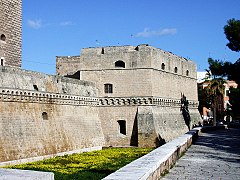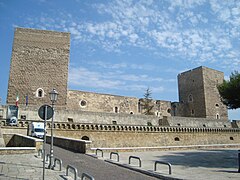| This article needs additional citations for verification. Please help improve this article by adding citations to reliable sources. Unsourced material may be challenged and removed. Find sources: "Castello Normanno-Svevo" Bari – news · newspapers · books · scholar · JSTOR (August 2015) (Learn how and when to remove this message) |
| Norman-Swabian Castle | |
|---|---|
| Castello Normanno-Svevo | |
| Bari, Apulia, Italy | |
 Western ramparts of the castle Western ramparts of the castle | |
| Coordinates | 41°7′43″N 16°51′59″E / 41.12861°N 16.86639°E / 41.12861; 16.86639 |
| Site information | |
| Open to the public | yes |
| Site history | |
| Built | 1132 (1132) |
| Built by | Norman king Roger II Rebuild by Frederick II of Sicily |
The Castello Normanno-Svevo or Norman-Swabian Castle (Italian: Castello normanno-svevo), also known as the u Castídde in the Barese dialect, is a castle in the Apulian city of Bari, Italy.
Built around 1132 by Norman king Roger II, it is currently used for exhibitions.
History
Probably built in 1132 by Norman King Roger II, it was destroyed in 1156 by king William I of Sicily and rebuilt and reinforced in 1233 by Fredrick II, then King of Sicily. During the Angevin domination, it went through several transformations, and after being acquired by Duke Ferdinand of Aragon, was donated to the Sforza family and passed to Bona Sforza, Queen of Poland. After Bona's death, it was returned under the King of Naples and transformed into a prison and barracks.
The castle is surrounded by a moat on all sides, except the northern section, which was bordering the sea and can be accessed from the bridge and the gate on the southern side. It is mainly composed of the Aragon walls and the main Hohenstaufen tower, and is currently used for exhibitions.
According to the tradition, in 1221 Frederick II met St. Francis of Assisi in this castle. According to tradition, Frederick had a courtesan sent to Francis's room and watched through a peephole to see what would happen. When Francis sent the woman away, Frederick was impressed with his principles; the two spent the rest of the night in conversation. This story is not confirmed beyond doubt, but it is considered believable.
Gallery
References
- ^ "Castello Normanno-Svevo - Comune di Bari". www.comune.bari.it (in Italian). Retrieved 2023-10-09.
- Georgina Masson. Frederick II of Hohenstaufen: a life. pp. 88-89.





